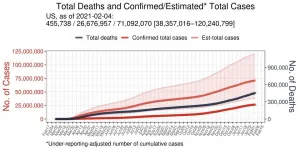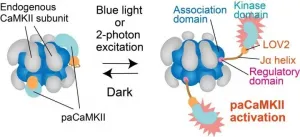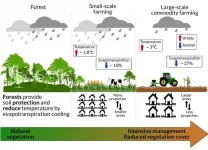(Press-News.org) A global survey of healthcare providers by the International Osteoporosis Foundation (IOF), the National Osteoporosis Foundation (NOF) and the European Society for Clinical and Economic Aspects of Osteoporosis, Osteoarthritis and Musculoskeletal Diseases (ESCEO) has revealed unprecedented effects of the Covid-19 pandemic on worldwide healthcare delivery for osteoporosis.
Osteoporosis is a chronic, age-related disease which is associated with life-changing fragility fractures. Approximately 740,000 people lose their lives following hip fractures every year.
The survey report is based on online questionnaires completed from April to June 2020 by 209 healthcare providers in 53 countries: 28% from Europe, 24% from North America, and 19%, 17% and 12% from the Asia-Pacific, Middle East and Latin America, respectively. The majority of the respondents (85%) were physicians, mainly representing the specialties of rheumatology (40%), endocrinology (22%), orthopaedics (15%) and internal medicine (11%).
The report provides an insight into how healthcare delivery for osteoporosis has been affected by the pandemic:
Clinic/hospital closures: 21% of institutions were only open for emergency visits; 23% for non-acute/routine visits; 57% for both emergency and routine appointments; and 7% closed for all visit types.
Form of consultations: 33% performed telephone consultations; 21% video consultations; 26% face-to-face appointments; 18% urgent in-person visits; and 3% other modalities (including instant messaging).
Telemedicine: Lock-downs and self-isolation saw a necessary move toward telemedicine, which was found very useful for 20% of the respondents, who scheduled approximately more than 20 online appointments per week. In contrast, 20% only scheduled 1-5 appointments per week and 20 % did not schedule any appointments at all. Issues included unavailability of telemedicine, its non-reimbursement, or uncertainties about reimbursement.
Risk Assessment: 29% scheduled a Dual-energy X-ray Absorptiometry (DXA) scan as soon as possible in order to inform treatment decisions; 11% assessed patients based on a clinical risk calculator alone (for e.g. FRAX®); 29% assessed patients based on a risk calculator with a planned DXA at a later date; 33% postponed a DXA; 5% indicated that their DXA unit was currently closed or that they were referring patients to a fracture clinic service.
Delivery of medication: Almost half (43%) reported difficulty arranging osteoporosis medications, including limited supply or difficult in acquiring medications, delay in administration of infusions and injections, reluctance on the part of patients to attend, or travel restrictions/self-isolation resulting in patients being unable to attend office visits.
Prescriptions: 28% prescribed refills only; 63% prescribed both refills and new prescriptions; 3% issued new prescriptions only; and 4% did not prescribe any medication unless for an acute indication.
Professionally administered treatment: 60% of clinicians had systems in place to identify patients receiving parenteral medication so that plans of care could be arranged; 46% were able to administer injections or infusions with safeguards in place to minimize patient risk; 3% moved treatments to an alternate clinical location; 21% suggested delaying treatment until Covid-19 risk had abated; 13% recommended switch to an oral medication; and 8% considered arranging in-home administration of treatment.
Time needed for patient charts/electronic health records: 93% of the respondents reported that it took as much or more time than prior to the pandemic to complete documentation. Reasons included technical and work-flow related issues, among others.
Patient follow-up: The time taken to follow-up patients was reported as greater by 39% of respondents, less by 9%, no change by 45%, and 7% of respondents were unsure. More time was often required to provide explanations or results over the phone, among other reasons.
IOF President Professor Cyrus Cooper, corresponding author, noted:
"The survey indicates that the identification and management of osteoporosis in patients has been profoundly affected by the pandemic, by delays in obtaining a DXA scan or in providing medication. There is a concern that the traditional gold standard assessment and management of osteoporosis patients was not performed in the majority of cases during the pandemic, leaving many patients without assessment and treatment."
Professor Susan L. Greenspan, President of NOF and senior author, stated:
"There appears to be a substantial impact on reimbursement, which may have implications for the ability to sustain and offer various osteoporosis clinical services and tests such as DXA. In the USA, despite Medicare allowing greater flexibility for home administration of injectable medication, some 39% of survey respondents were either not sure about the new arrangement or would not consider using this option. This could potentially lead to a reduction in resources, and corresponding decrease in the assessment and treatment of patients with osteoporosis and related fracture."
On a positive note almost one in three healthcare providers performed telephone consultations and one in five performed video consultations. Telemedicine has potential benefits for patients and can result in savings and efficiencies for healthcare systems. In some countries, temporary adjustments made to telemedicine reimbursement rates during the pandemic are being evaluated for implications and opportunities in the future when societies return to the new 'normal'.
INFORMATION:
Further reading
Fuggle, N.R., Singer, A., Gill, C. et al. How has COVID-19 affected the treatment of osteoporosis? An IOF-NOF-ESCEO global survey. Osteoporos Int (2021). https://link.springer.com/article/10.1007/s00198-020-05793-3
McCloskey, E.V., Harvey, N.C., Johansson, H. et al. Global impact of COVID-19 on non-communicable disease management: descriptive analysis of access to FRAX fracture risk online tool for prevention of osteoporotic fractures. Osteoporos Int (2020). https://doi.org/10.1007/s00198-020-05542-6
Clynes, M.A., Westbury, L.D., Dennison, E.M. et al. Bone densitometry worldwide: a global survey by the ISCD and IOF. Osteoporos Int (2020). https://link.springer.com/article/10.1007/s00198-020-05435-8
Covid-19: Updates and Resources (NOF-USA)
https://www.nof.org/covid-19-updates/
Covid-19: Simplified procedures for Fracture Liaison Services
https://www.capturethefracture.org/covid-19-all-ctf-fls-centers
About the International Osteoporosis Foundation:
The International Osteoporosis Foundation (IOF) is the world's largest nongovernmental organization dedicated to the prevention, diagnosis and treatment of osteoporosis and related musculoskeletal diseases. IOF members, including committees of scientific researchers as well as 266 patient, medical and research societies, work together to make fracture prevention and healthy mobility a worldwide health care priority. http://www.osteoporosis.foundation @iofbonehealth
About the National Osteoporosis Foundation:
Established in 1984, the National Osteoporosis Foundation is the nation's leading health organization dedicated to preventing osteoporosis and broken bones, promoting strong bones for life and reducing human suffering through programs of awareness, education, advocacy and research. For more information on the National Osteoporosis Foundation, visit http://www.nof.org.
DALLAS - Feb. 8, 2021 - World health experts have long suspected that the incidence of COVID-19 has been higher than reported. Now, a machine-learning algorithm developed at UT Southwestern estimates that the number of COVID-19 cases in the U.S. since the pandemic began is nearly three times that of confirmed cases.
The algorithm, described in a study published today in PLOS ONE, provides daily updated estimates of total infections to date as well as how many people are currently infected across the U.S. and in 50 countries hardest hit by the pandemic.
As of Feb. 4, according to ...
As teens' use of social media has grown over the past decade, so too has the suicide rate among younger people, with suicide now being the second leading cause of death among those ages 10 to 34. Many have suggested that social media is driving the increased suicide risk, but because social media is still relatively new, it's been difficult to determine its long-term effects on mental health.
In the longest study to date on social media use and suicidality, BYU research recently published in the Journal of Youth and Adolescence now offers some answers.
Through ...
One of the dozens of unusual symptoms that have emerged in COVID-19 patients is a condition that's informally called "COVID brain" or "brain fog." It's characterized by confusion, headaches, and loss of short-term memory. In severe cases, it can lead to psychosis and even seizures. It usually emerges weeks after someone first becomes sick with COVID-19.
In the February 8, 2021, issue of the journal Cancer Cell, a multidisciplinary team from Memorial Sloan Kettering reports an underlying cause of COVID brain: the presence of inflammatory molecules in the liquid surrounding the brain and spinal cord (called the cerebrospinal fluid). The findings suggest that anti-inflammatory drugs, such as steroids, may ...
Exposure to sexual assault in the U.S. military doubled the odds that a service member would leave the military within 28 months, and sexual harassment was associated with roughly 8% of all military separations during this same time period, according to a new report from the RAND Corporation.
Specifically, the report estimates that sexual assaults were associated with 2,000 more separations than would normally be expected, and another 8,000 separations were associated with sexual harassment.
"Sexual assault and sexual harassment are associated with a wide range of harms to individual service members, but this study highlights another negative impact of these crimes - higher rates of attrition and associated harms to force readiness." said Andrew ...
The world is changing rapidly and in order to serve the human population dealing with those changes, American universities need to change, too. In fact, their role is to model the resiliency that all institutions need to embrace, according to Arizona State University President Michael M. Crow.
While many leading universities are poised to advance society and help respond to the challenges of disruptive change through their traditional role in education and discovery, many face a number of barriers that make them less prepared to respond to the rapidly changing conditions and the demands they create.
What is emerging is a new type of university, one that steps beyond the American research university model and ...
Not all friendships are created equal. Some friends get along; others struggle to avoid conflict. Conventional wisdom holds that the tenor of a friendship with someone who is nice differs from that with someone who is mean, such that the former discourages negative interactions whereas the latter aggravates them. Although it is logical to assume that children who are mean have friendships characterized by growing strife and that children who are nice report little of the same, these assumptions have not yet been tested in the real-world friendships of children.
Researchers from Florida Atlantic University's Charles E. Schmidt College of Science are the first to conduct a longitudinal study to examine the extent to which being "nice" (prosocial behavior) and being "mean" (relationally aggressive ...
A new study from University of Alberta researchers has shown that traumatic or stressful events in childhood may lead to tiny changes in key brain structures that can now be identified decades later.
The study is the first to show that trauma or maltreatment during a child's early years--a well-known risk factor for developing mental health conditions such as major depressive disorder in adulthood--triggers changes in specific subregions of the amygdala and the hippocampus.
Once these changes occur, researchers believe the affected regions of the brain may not function as well, potentially increasing the risk of developing mental health disorders as adults during times of stress.
"Now ...
CORVALLIS, Ore. - Marching band members in leadership roles are more likely to feel discomfort in the neck and upper back than their less experienced bandmates, who in turn are more susceptible to left-hand pain and cognitive strain, a new study by Oregon State University suggests.
The findings also showed that gender had no bearing on how much discomfort a musician felt or the band member's perception of workload.
"The study really seems to indicate that a player's level of experience and role within the band are what drive how much discomfort they feel," said industrial ...
Neurons are the primary cells of the nervous system, and the signals that are transmitted between them are responsible for all our actions and our cognitive ability. In particular, learning and memory are believed to be associated with a process called "long-term potentiation," which is the strengthening of connections between specific neurons via continued signal transmission through "synapses" (small gaps between neurons). Long-term potentiation can change the connection between neurons via synapses--by changing their size and composition. Understanding ...
Researchers report that large-scale commercial farms on deforested land in the southern Amazon result in higher temperature increases and less rainfall than small-scale farms.
Deforestation has converted swaths of land in the southern Amazon region from rainforest to farmland. The uses of the deforested land are diverse, and activities can range from small-scale farming in rural settlements to large-scale commodity agriculture. Commercial farms in the Southern Amazon can reach hundreds of thousands of hectares in area, exporting millions of tons in grains and beef every year.
Eduardo Maeda from the University of Helsinki and colleagues used satellite data to compare areas dominated by different land uses and farm sizes to evaluate their impacts on ...





